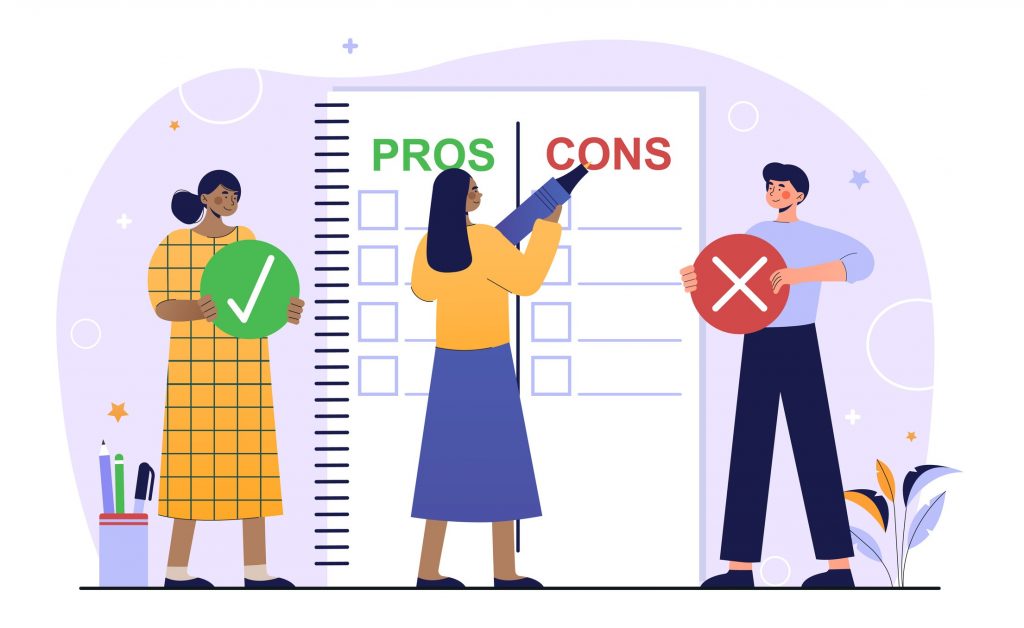Your employees are talking about salaries, even if you’re not.
With each generation, salary discussions have become less taboo.
A poll by Bankrate with approximately 2,500 people showed an increase in the number of adults openly discussing their salaries.
- Gen Z (18-25 years old): 42%
- Millennials (26-41 years old): 40%
- Gen X (42-57 years old): 31%
- Baby boomers (58-76 years old): 19%
And far-reaching informational job boards like Glassdoor only help to increase the knowledge that’s out there.
Salary Transparency Pros and Cons

Many think pay transparency helps to improve several aspects of the workforce, but most also admit there is a downside.
Pro
Those watercooler discussions about who makes more, who shouldn’t be making more, and what that person makes are an age-old professional pastime. The problem is that it becomes like a game of telephone where the origin is hazy and may not even be correct. Without it coming from the horse’s mouth, salary talk is heresy, and as we know, misinformation travels fast. Being open about salaries will eliminate rumors.
Con
Jealousy exists whether something is true or not, so revealing salaries to your employees will always end with someone feeling slighted by the transparent salary.
Pro
Perhaps some salaries need to be examined for pay discrepancies. Maybe some don’t belong the way they are. Does Person A deserve to be making more than Person B? Several criteria are involved here. Still, the bottom line is that if you reveal salaries to your employees, you need solid answers as to why they are the way they are. Your employees deserve these answers, and it’s good for you to do a deep dive now and again to ensure everything is fair.
Con
Job families. In other words, jobs fall under different categories, like a marketing department or accounting department, and not everyone is created equal. Why? Crudely speaking, supply and demand. There are other factors that go into someone’s salary; Years of schooling, years of experience, performance, responsibilities, number of years at the company, how specialized their position is, etc. All these things factor into what essentially breaks down to monetary worth, and putting a number value to a person rarely sits well. Now add however many employees you have at your company, and there are guaranteed to be a few unhappy campers. While a person feels they work just as hard as another, it still may translate to a different number, and that’s tough to explain again and again, especially if the one that makes more money than the other isn’t happy either. You need to get your facts straight and be prepared with answers.
Pro
Inequality becomes visible through wage gaps. Gender inequality (gender-based wage discrimination), racial inequality (race pay gap), and more.
According to a Pew Research Center study, in 2020, women made about 84% of what men made. According to a research analysis by PayScale in 2019, black men earned 13 cents less for every dollar paid to a white man. Hispanic men earned 19 cents less. While Asian male workers earned up to 15 cents more than a white male worker. Several sources, including the US Census Bureau, indicate that black female workers earned 36 cents less for every dollar earned by a white male worker and 15 cents less than a white female worker. Hispanic women earned 43 cents less than a white male worker and 22 cents less than a white female worker. Asian women made the most, earning $1.01 for every dollar a white man earned.
Tightening the study to those who hold the same positions and experience level narrows the gaps to some degree, but they remain just the same.
Con
Some just plain don’t like it. More traditional employees may not appreciate their salary being revealed. Those with high or low wages can get embarrassed.
Talk to your employees; don’t blindside them.
Pro
Productivity increases.
Tel Aviv University conducted a study where 280 undergrad students were paid to take part in a skill-based computer game. Only half had full knowledge of the pay structure for all participants, while the other half just knew theirs. Those left partially in the dark did worse. In the second round, participants privy to all pay info worked harder.
Con
Productivity decreases.
A study performed by Scott Rick, Assistant Director of Marketing at the University of Michigan, showed that when given a task of counting dots, the people who made less and knew it performed worse and were also more likely to falsify the outcome of their work.
Pro
Your ability to onboard new employees and maintain a higher retention rate will likely increase.
Glassdoor found that 63% of employees prefer companies that provide pay disclosure.
Equal Pay for Equal Work

More businesses and the states that they operate in are moving toward some type of pay transparency law. On January 1st, 2021, Colorado passed the Equal Pay for Equal Work Act to eliminate wage discrimination. The law made it illegal for businesses to pay men more than women for the same job. The law also mandated that salary ranges be displayed in all job postings, and made it illegal to ask about a person’s previous salary in an interview. The law additionally required all job postings to be shared with every employee.
Some companies have gone further, laying everything out on the table. PayScale even created a five-stage system to show the increasing levels of pay transparency. Stage 1 is simply telling the hired employee how much they make. The fifth stage was making all salary information available to every employee (open salaries). Software and marketing company, Buffer, even went public with their employee salaries.
Where Do You Stand?
While we have to adhere to legal guidelines for pay transparency, there are still individual decisions to be made about making salaries transparent. Ultimately, you must decide what level of salary transparency works best for your company and its employees.
Check out CardsDirect.com for more ways to improve your professional and personal relationships.

